- Home
- Steven Pressfield
The War of Art Page 5
The War of Art Read online
Page 5
The professional cannot live like that. He is on a mission. He will not tolerate disorder. He eliminates chaos from his world in order to banish it from his mind. He wants the carpet vacuumed and the threshold swept, so the Muse may enter and not soil her gown.
A PROFESSIONAL DEMYSTIFIES
* * *
A pro views her work as craft, not art. Not because she believes art is devoid of a mystical dimension. On the contrary. She understands that all creative endeavor is holy, but she doesn’t dwell on it. She knows if she thinks about that too much, it will paralyze her. So she concentrates on technique. The professional masters how, and leaves what and why to the gods. Like Somerset Maugham she doesn’t wait for inspiration, she acts in the anticipation of its apparition. The professional is acutely aware of the intangibles that go into inspiration. Out of respect for them, she lets them work. She grants them their sphere while she concentrates on hers.
The sign of the amateur is overglorification of and preoccupation with the mystery.
The professional shuts up. She doesn’t talk about it. She does her work.
A PROFESSIONAL ACTS IN THE
FACE OF FEAR
* * *
The amateur believes he must first overcome his fear; then he can do his work. The professional knows that fear can never be overcome. He knows there is no such thing as a fearless warrior or a dread-free artist.
What Henry Fonda does, after puking into the toilet in his dressing room, is to clean up and march out onstage. He’s still terrified but he forces himself forward in spite of his terror. He knows that once he gets out into the action, his fear will recede and he’ll be okay.
A PROFESSIONAL
ACCEPTS NO EXCUSES
* * *
The amateur, underestimating Resistance’s cunning, permits the flu to keep him from his chapters; he believes the serpent’s voice in his head that says mailing off that manuscript is more important than doing the day’s work.
The professional has learned better. He respects Resistance. He knows if he caves in today, no matter how plausible the pretext, he’ll be twice as likely to cave in tomorrow.
The professional knows that Resistance is like a telemarketer; if you so much as say hello, you’re finished. The pro doesn’t even pick up the phone. He stays at work.
A PROFESSIONAL
PLAYS IT AS IT LAYS
* * *
My friend the Hawk and I were playing the first hole at Prestwick in Scotland; the wind was howling out of the left. I started an eight-iron thirty yards to windward, but the gale caught it; I watched in dismay as the ball sailed hard right, hit the green going sideways, and bounded off into the cabbage. “Sonofabitch!” I turned to our caddie. “Did you see the wind take that shot!?”
He gave that look that only Scottish caddies can give. “Well, ye’ve got t’ play th’ wind now, don’t ye?”
The professional conducts his business in the real world. Adversity, injustice, bad hops and rotten calls, even good breaks and lucky bounces all comprise the ground over which the campaign must be waged. The field is level, the professional understands, only in heaven.
A PROFESSIONAL IS PREPARED
* * *
I’m not talking about craft; that goes without saying. The professional is prepared at a deeper level. He is prepared, each day, to confront his own self-sabotage.
The professional understands that Resistance is fertile and ingenious. It will throw stuff at him that he’s never seen before.
The professional prepares mentally to absorb blows and to deliver them. His aim is to take what the day gives him. He is prepared to be prudent and prepared to be reckless, to take a beating when he has to, and to go for the throat when he can. He understands that the field alters every day. His goal is not victory (success will come by itself when it wants to) but to handle himself, his insides, as sturdily and steadily as he can.
A PROFESSIONAL
DOES NOT SHOW OFF
* * *
A professional’s work has style; it is distinctively his own. But he doesn’t let his signature grandstand for him. His style serves the material. He does not impose it as a means of drawing attention to himself.
This doesn’t mean that the professional doesn’t throw down a 360 tomahawk jam from time to time, just to let the boys know he’s still in business.
A PROFESSIONAL
DEDICATES HIMSELF
TO MASTERING TECHNIQUE
* * *
The professional respects his craft. He does not consider himself superior to it. He recognizes the contributions of those who have gone before him. He apprentices himself to them.
The professional dedicates himself to mastering technique not because he believes technique is a substitute for inspiration but because he wants to be in possession of the full arsenal of skills when inspiration does come. The professional is sly. He knows that by toiling beside the front door of technique, he leaves room for genius to enter by the back.
A PROFESSIONAL
DOES NOT HESITATE
TO ASK FOR HELP
* * *
Tiger Woods is the greatest golfer in the world. Yet he has a teacher; he works with Butch Harmon. And Tiger doesn’t endure this instruction or suffer through it—he revels in it. It’s his keenest professional joy to get out there on the practice tee with Butch, to learn more about the game he loves.
Tiger Woods is the consummate professional. It would never occur to him, as it would to an amateur, that he knows everything, or can figure everything out on his own. On the contrary, he seeks out the most knowledgeable teacher and listens with both ears. The student of the game knows that the levels of revelation that can unfold in golf, as in any art, are inexhaustible.
A PROFESSIONAL
DISTANCES HERSELF
FROM HER INSTRUMENT
* * *
The pro stands at one remove from her instrument— meaning her person, her body, her voice, her talent; the physical, mental, emotional, and psychological being she uses in her work. She does not identify with this instrument. It is simply what God gave her, what she has to work with. She assesses it coolly, impersonally, objectively.
The professional identifies with her consciousness and her will, not with the matter that her consciousness and will manipulate to serve her art. Does Madonna walk around the house in cone bras and come-fuck-me bustiers? She’s too busy planning D-Day. Madonna does not identify with “Madonna.” Madonna employs “Madonna.”
A PROFESSIONAL
DOES NOT TAKE FAILURE
(OR SUCCESS) PERSONALLY
* * *
When people say an artist has a thick skin, what they mean is not that the person is dense or numb, but that he has seated his professional consciousness in a place other than his personal ego. It takes tremendous strength of character to do this, because our deepest instincts run counter to it. Evolution has programmed us to feel rejection in our guts. This is how the tribe enforced obedience, by wielding the threat of expulsion. Fear of rejection isn’t just psychological; it’s biological. It’s in our cells.
Resistance knows this and uses it against us. It uses fear of rejection to paralyze us and prevent us, if not from doing our work, then from exposing it to public evaluation. I had a dear friend who had labored for years on an excellent and deeply personal novel. It was done. He had it in its mailing box. But he couldn’t make himself send it off. Fear of rejection unmanned him.
The professional cannot take rejection personally because to do so reinforces Resistance. Editors are not the enemy; critics are not the enemy. Resistance is the enemy. The battle is inside our own heads. We cannot let external criticism, even if it’s true, fortify our internal foe. That foe is strong enough already.
A professional schools herself to stand apart from her performance, even as she gives herself to it heart and soul. The Bhagavad-Gita tells us we have a right only to our labor, not to the fruits of our labor. All the warrior can give is his life; all t
he athlete can do is leave everything on the field.
The professional loves her work. She is invested in it wholeheartedly. But she does not forget that the work is not her. Her artistic self contains many works and many performances. Already the next is percolating inside her. The next will be better, and the one after that better still.
The professional self-validates. She is tough-minded. In the face of indifference or adulation, she assesses her stuff coldly and objectively. Where it fell short, she’ll improve it. Where it triumphed, she’ll make it better still. She’ll work harder. She’ll be back tomorrow.
The professional gives an ear to criticism, seeking to learn and grow. But she never forgets that Resistance is using criticism against her on a far more diabolical level. Resistance enlists criticism to reinforce the fifth column of fear already at work inside the artist’s head, seeking to break her will and crack her dedication. The professional does not fall for this. Her resolution, before all others, remains: No matter what, I will never let Resistance beat me.
A PROFESSIONAL
ENDURES ADVERSITY
* * *
I had been in Tinseltown five years, had finished nine screenplays on spec, none of which had sold. Finally I got a meeting with a big producer. He kept taking phone calls, even as I pitched my stuff. He had one of those headset things, so he didn’t even have to pick up a receiver; the calls came in and he took them. Finally one came that was personal. “Would you mind?” he asked, indicating the door. “I need some privacy on this one.” I exited. The door closed behind me. Ten minutes passed. I was standing out by the secretaries. Twenty more minutes passed. Finally the producer’s door opened; he came out pulling on his jacket. “Oh, I’m so sorry!”
He had forgotten all about me.
I’m human. This hurt. I wasn’t a kid either; I was in my forties, with a rap sheet of failure as long as your arm.
The professional cannot let himself take humiliation personally. Humiliation, like rejection and criticism, is the external reflection of internal Resistance.
The professional endures adversity. He lets the birdshit splash down on his slicker, remembering that it comes clean with a heavy-duty hosing. He himself, his creative center, cannot be buried, even beneath a mountain of guano. His core is bulletproof. Nothing can touch it unless he lets it.
I saw a fat happy old guy once in his Cadillac on the freeway. He had the A/C going, Pointer Sisters on the CD, puffing on a stogie. His license plate:
DUES PD
The professional keeps his eye on the doughnut and not on the hole. He reminds himself it’s better to be in the arena, getting stomped by the bull, than to be up in the stands or out in the parking lot.
A PROFESSIONAL SELF-VALIDATES
* * *
An amateur lets the negative opinion of others unman him. He takes external criticism to heart, allowing it to trump his own belief in himself and his work. Resistance loves this.
Can you stand another Tiger Woods story? With four holes to go on the final day of the 2001 Masters (which Tiger went on to win, completing the all-four-majors-at-one-time Slam), some chucklehead in the gallery snapped a camera shutter at the top of Tiger’s backswing. Incredibly, Tiger was able to pull up in mid-swing and back off the shot. But that wasn’t the amazing part. After looking daggers at the malefactor, Tiger recomposed himself, stepped back to the ball, and striped it 310 down the middle.
That’s a professional. It is tough-mindedness at a level most of us can’t comprehend, let alone emulate. But let’s look more closely at what Tiger did, or rather what he didn’t do.
First, he didn’t react reflexively. He didn’t allow an act that by all rights should have provoked an automatic response of rage to actually produce that rage. He controlled his reaction. He governed his emotion.
Second, he didn’t take it personally. He could have perceived this shutterbug’s act as a deliberate blow aimed at him individually, with the intention of throwing him off his shot. He could have reacted with outrage or indignation or cast himself as a victim. He didn’t.
Third, he didn’t take it as a sign of heaven’s malevolence. He could have experienced this bolt as the malice of the golfing gods, like a bad hop in baseball or a linesman’s miscall in tennis. He could have groaned or sulked or surrendered mentally to this injustice, this interference, and used it as an excuse to fail. He didn’t.
What he did do was maintain his sovereignty over the moment. He understood that, no matter what blow had befallen him from an outside agency, he himself still had his job to do, the shot he needed to hit right here, right now. And he knew that it remained within his power to produce that shot. Nothing stood in his way except whatever emotional upset he himself chose to hold on to. Tiger’s mother, Kultida, is a Buddhist. Perhaps from her he had learned compassion, to let go of fury at the heedlessness of an overzealous shutter-clicker. In any event Tiger Woods, the ultimate professional, vented his anger quickly with a look, then recomposed himself and returned to the task at hand.
The professional cannot allow the actions of others to define his reality. Tomorrow morning the critic will be gone, but the writer will still be there facing the blank page. Nothing matters but that he keep working. Short of a family crisis or the outbreak of World War III, the professional shows up, ready to serve the gods.
Remember, Resistance wants us to cede sovereignty to others. It wants us to stake our self-worth, our identity, our reason-for-being, on the response of others to our work. Resistance knows we can’t take this. No one can.
The professional blows critics off. He doesn’t even hear them. Critics, he reminds himself, are the unwitting mouthpieces of Resistance and as such can be truly cunning and pernicious. They can articulate in their reviews the same toxic venom that Resistance itself concocts inside our heads. That is their real evil. Not that we believe them, but that we believe the Resistance in our own minds, for which critics serve as unconscious spokespersons.
The professional learns to recognize envy-driven criticism and to take it for what it is: the supreme compliment. The critic hates most that which he would have done himself if he had had the guts.
A PROFESSIONAL
RECOGNIZES HER LIMITATIONS
* * *
She gets an agent, she gets a lawyer, she gets an accountant. She knows she can only be a professional at one thing. She brings in other pros and treats them with respect.
A PROFESSIONAL
REINVENTS HIMSELF
* * *
Goldie Hawn once observed that there are only three ages for an actress in Hollywood: “Babe, D.A., and Driving Miss Daisy.” She was making a different point, but the truth remains: As artists we serve the Muse, and the Muse may have more than one job for us over our lifetime.
The professional does not permit himself to become hidebound within one incarnation, however comfortable or successful. Like a transmigrating soul, he shucks his outworn body and dons a new one. He continues his journey.
A PROFESSIONAL IS RECOGNIZED
BY OTHER PROFESSIONALS
* * *
The professional senses who has served his time and who hasn’t. Like Alan Ladd and Jack Palance circling each other in Shane, a gun recognizes another gun.
YOU, INC.
* * *
When I first moved to Los Angeles and made the acquaintance of working screenwriters, I learned that many had their own corporations. They provided their writing services not as themselves but as “loan-outs” from their one-man businesses. Their writing contracts were f/s/o —“for services of ”— themselves. I had never seen this before. I thought it was pretty cool.
For a writer to incorporate himself has certain tax and financial advantages. But what I love about it is the metaphor. I like the idea of being Myself, Inc. That way I can wear two hats. I can hire myself and fire myself. I can even, as Robin Williams once remarked of writer-producers, blow smoke up my own ass.
Making yourself a corporation (or just
thinking of yourself in that way) reinforces the idea of professionalism because it separates the artist-doing-the-work from the will-and-consciousness-running-the-show. No matter how much abuse is heaped on the head of the former, the latter takes it in stride and keeps on trucking. Conversely with success: You-the-writer may get a swelled head, but you-the-boss remember how to take yourself down a peg.

 The Legend of Bagger Vance: A Novel of Golf and the Game of Life
The Legend of Bagger Vance: A Novel of Golf and the Game of Life The Lion's Gate: On the Front Lines of the Six Day War
The Lion's Gate: On the Front Lines of the Six Day War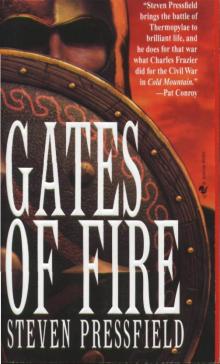 Gates of Fire
Gates of Fire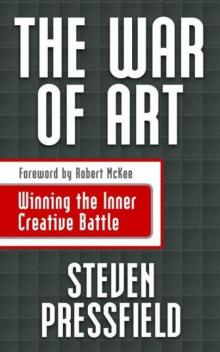 The War of Art
The War of Art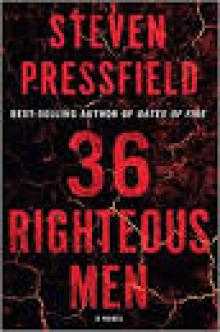 36 Righteous Men
36 Righteous Men The Virtues of War
The Virtues of War The Afghan Campaign
The Afghan Campaign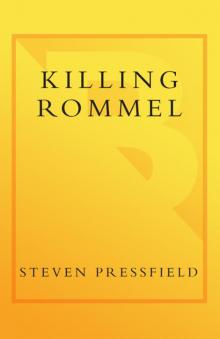 Killing Rommel
Killing Rommel Last of the Amazons Last of the Amazons Last of the Amazons
Last of the Amazons Last of the Amazons Last of the Amazons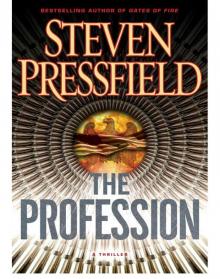 The Profession
The Profession Last of the Amazons
Last of the Amazons The Lion’s Gate
The Lion’s Gate The Legend of Bagger Vance
The Legend of Bagger Vance Virtues of War
Virtues of War Tides of War, a Novel of Alcibiades and the Peloponnesian War
Tides of War, a Novel of Alcibiades and the Peloponnesian War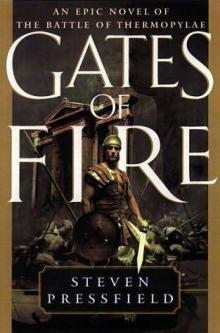 Gates of Fire: An Epic Novel of the Battle of Thermopylae
Gates of Fire: An Epic Novel of the Battle of Thermopylae The Afgan Campaign
The Afgan Campaign